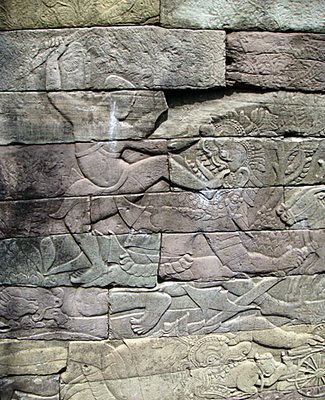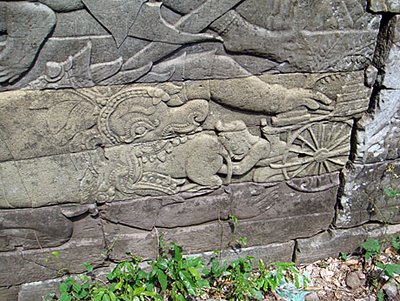Rahu bas-reliefs
Banteay Chhmar is also famous for its Bayon-style bas-reliefs along its outer gallery, though existing in two registers, rather than the four as at the Bayon. The reliefs present a mix of historic events with religious and mythological themes though large chunks of the gallery has fallen foul to time and thieves. The most striking example of this was the theft of five portions of the wall in 1997 which included the large, multi-armed Avalokiteshvaras. Only two remain in place today. Along the gallery wall are a series of rich iconographic scenes and the two featured here involve the mythical monster Bharata Rahu. Located in the southern part of the western gallery near the western gopura 153, the picture above depicts a large man trying to kill the rebellious Bharata Rahu, in a forest setting with rhinoceros and monkeys present. The man is believed to be Prince Shrindrakumara and in the process he saves the royal palace of Yashovarman. Believe it if you will. In the bottom photo, a monstrously large figure with the head of a lion (though it looks like Rahu to me) and crawling on the ground, is just about to devour a Cham, an ox and his chariot of boxes arranged in a pyramid. This relief is the only known Rahu relief in Cambodia. Normally Rahu, who stole a drop of amrita at the Churning of the Ocean of Milk and achieved immortality, is seen swallowing the sun and the moon and creating eclipses. Also in Khmer folklore, the term Rahu often refers to the grimacing face of a kala and can be seen on many lintels.




4 Comments:
For you, my brother, who spends part of his life among the ruins, I have specially translated this passage from an early 20th-century traveller to Cambodia, Élie Faure:
"On condition that we respect them, that we do not take them away, that we, after having inquired about their secret, let the ashes from the centuries, the bones of the dead, the piled debris of vegetation and races, the eternal cloth of foliage to cover them again - the destiny of ruins is moving. It is through them that we touch the depths of our history, in the same way that we reconnect with the roots of our life through the griefs and woes that have formed us. A ruin is a painful sight but for those incapable of participating through their action into the conquest of the present time. --- Élie Faure, 'The Ancient East'.
PS - is that what you call a visit "on the run"? what rich material! wonder what will you give us when you'll take your time
- hope the translation will sound passable... I'm not a native English or French-speaker.
Petrus
Dear Petrus,
what a lovely gift, thank you.
The cultural heritage of the Khmers is incredibly rich and diverse and I am pleased that my own inadequate attempt to highlight this, is enjoyed by others.
Thank you again,
Andy
Hi Petrus, hi Andy:
What a find! indeed a beautiful motto for temple-hunters and archaeologists! I tried to locate this passage in my own edition of Faure's L'Art Antique (where 'The Ancient East'is included), but to no use. Please could you refer the pages in your edition, or - if I'm not abusing your good-will - post the original quotation in French?
Thank you and Andy, very much.///Jean-Pierre Dorléac
Cher Andy,
sorry for occupying your blog with this futile attempt - and for my naïveté. I have just realized Petrus may never again visit these comments...
Congratulations for your brilliant blog, I have been reading it daily a year now. Pls keep it going!
J-PD
Post a Comment
<< Home